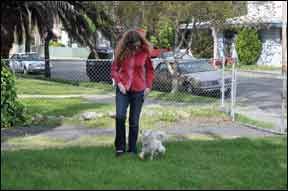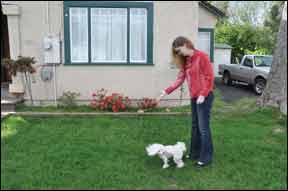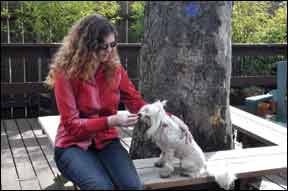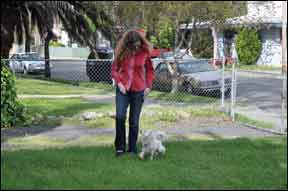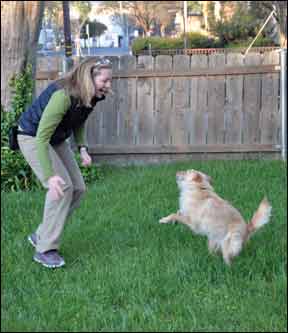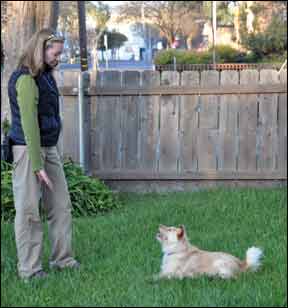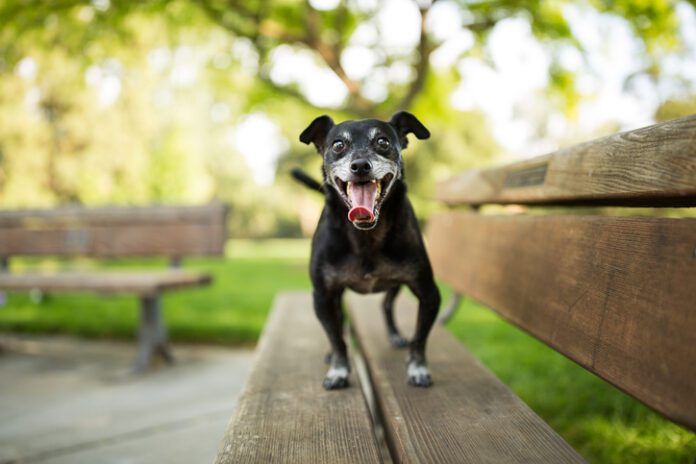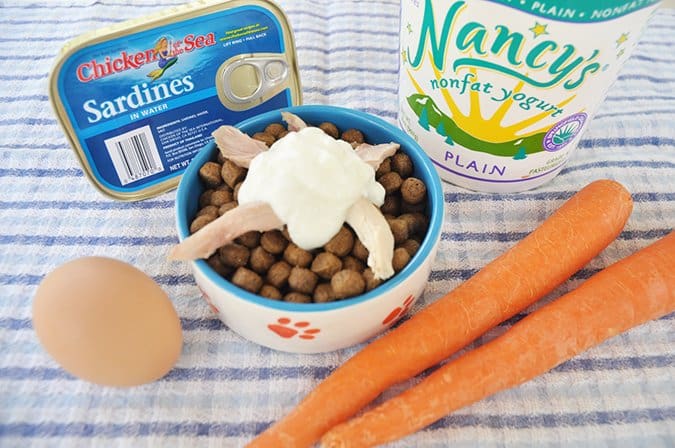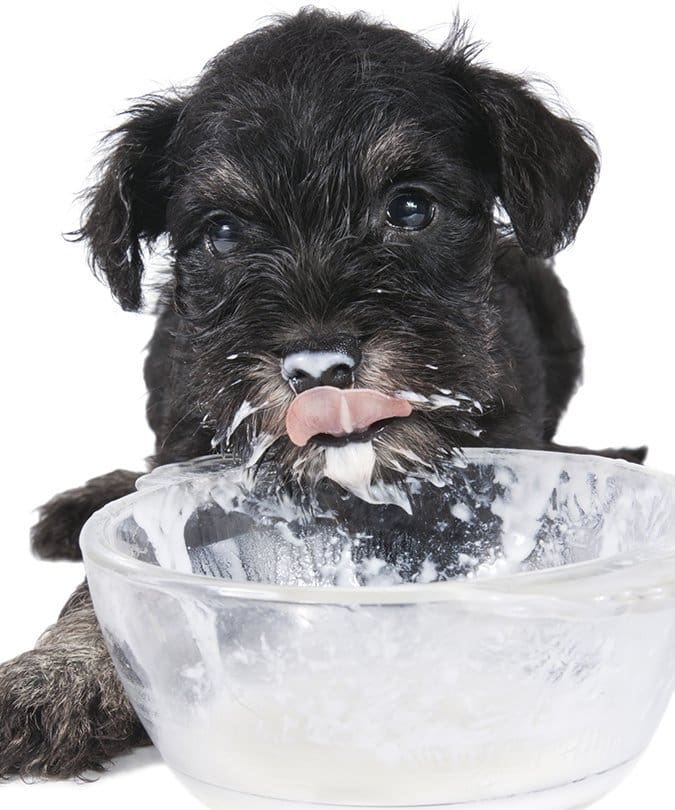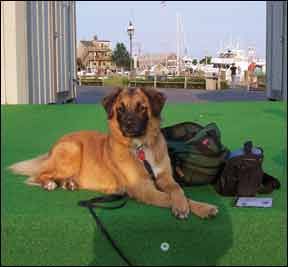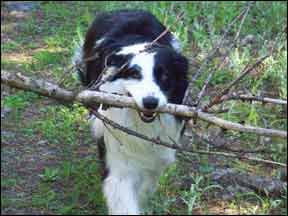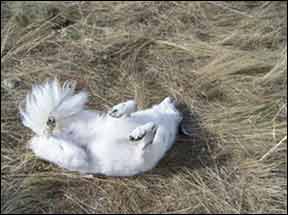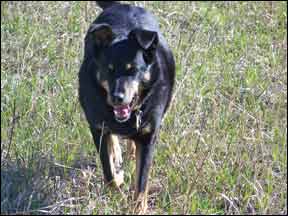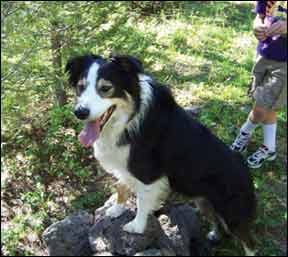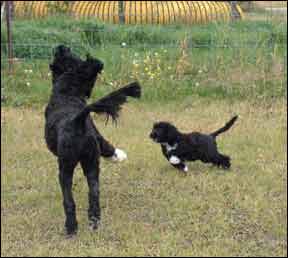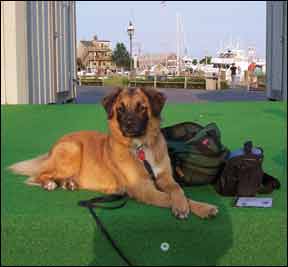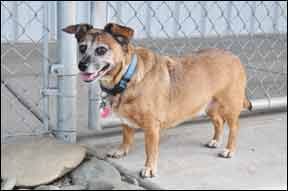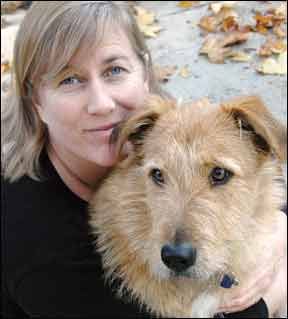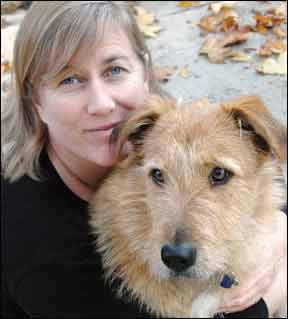Boy, do I wish I had a dollar for every time I heard someone say their dog was “hyperactive” or “ADHD” – I’d be a wealthy woman. In fact, those are clinical terms referring to very specific behavioral disorders (canine and human) that are relatively uncommon in dogs. In reality, most “hyper” dogs are just under-exercised. A couple of days hiking at the Peaceable Paws farm and you’d hardly know them.
Not every dog owner has access to large tracts of acreage upon which to exercise their hyper dogs, and in any case, “wild child canine syndrome” (WCCS) is more than just lack of exercise; it’s also lack of appropriate reinforcement for calm behavior – i.e., training. Unfortunately, all too often a dog loses his happy home – maybe even his life, as a result of his high-energy behavior.
We’ve seen several of these WCCS dogs at the training center in recent weeks. One private client decided to return her Shar-Pei-mix to the rescue from whence the pup came. Despite her best intentions and efforts, the client had mobility challenges that made it impossible for her to provide the pup with the exercise and management she needed. As painful as it was for the owner, returning the pup was the right decision.
Hyper dogs often include inappropriate biting in their repertoire of undesirable behaviors. We currently have a temporary foster resident at the training center: a 13-week-old high-energy Jack Russell Terrier who failed his assessment at the shelter for using his mouth in protest when restrained. Little Squid is a perfect example of the kind of dog who needs to learn self-control and the art of being calm.
A successful hyper dog behavior modification program contains three elements: physical exercise, management, and training. While any one of these alone can make your high-energy dog easier to live with, apply all three for maximum success. Let’s look at each of these elements in greater detail.
Exercise is Key for Managing Hyper Dogs
Squid’s day begins with an hour of barn-play while we do chores. He delights in harassing our dogs (and our pig). He gets at least one long hike around the farm per day, preferably two, or even three. He also gets one or more sessions of ball/toy fetch in the training center, and some puppy socialization/play time when there’s a class going on. Finally, he wraps up his day with evening barn chores. Does it tire him out? No. I have yet to see him tired. But it does take the edge off, so that when I work with him to teach calm he is able to focus and participate in the training. The physical exercise sets him up for training success.
Not everyone has an 80-acre farm to play on. If you’re farm-deprived, there are other ways to provide exercise for your WCCS dog. A placid walk or three around the block won’t do it. Nor will leaving him on his own in your fenced backyard. He needs to be actively engaged.
Outings to your local well-run dog park can be a good exercise option. If you don’t have one in your area, invite compatible canines over to play in your dog’s fenced yard. If you don’t have one, invite yourself and your dog over to your dog-friend’s fenced yard for play dates.
Absent any access to a dog-friendly fenced yard, play with your dog on a long line. A 50-foot line gives him a 100-foot stretch to run back and forth and work his jollies off.
Caution: Work up to 50 feet gradually, so he learns where the end of the line is. You don’t want him to blast full-speed to the end of his long line and hurt himself. Also, wear long pants. A high-speed long-line wrapped around bare legs can give you a nasty rope burn.
If none of those work for you, having him wear a pack when you walk him, or even better, pull a cart (which takes significant training), or exercising him (safely) from a bicycle may be options for using up excess energy.
Games for Hyperactive Dogs
If outside exercise is simply out of the question, here are some indoor activities that can help take the edge off for your hyper dog:
Find It
Most dogs love to use their noses. Take advantage of this natural talent by teaching yours the “Find It!” game:
1. Start with a handful of pea-sized tasty treats. Toss one to your left and say “Find it!” Then toss one to your other side and say “Find it!” Do this back and forth a half-dozen times.
2. Then have your dog sit and wait or stay, or have someone hold his leash. Walk 10 to 15 feet away and let him see you place a treat on the floor. Walk back to his side, pause, and say “Find it!” encouraging him to go get the treat. Repeat a half-dozen times.
3. Next, have your dog sit and wait or stay, or have someone hold his leash and let him see you “hide” the treat in an easy hiding place: behind a chair leg, under the coffee table, next to the plant stand. Walk back to his side, pause, and say “Find it!” encouraging him to go get the treat. Repeat a half-dozen times.
4. Again, have your dog sit and wait. This time hide several treats in easy places while he’s watching. Return to his side, pause, and say “Find it!” Be sure not to help him out if he doesn’t find them right away.
You can repeat the “find it” cue, and indicate the general area, but don’t show him where it is; you want him to have to work to find it.
5. Hide the treats in harder and harder places so he really has to look for them: surfaces off the ground; underneath things; and in containers he can easily open.
6. Finally, put him in another room while you hide treats. Bring him back into the room and tell him to “Find it!” and enjoy watching him work his powerful nose to find the goodies. Once you’ve taught him this step of the game you can use it to exercise him by hiding treats in safe places all over the house, and then telling him to “Find it!” Nose work is surprisingly tiring.
If you prefer something less challenging, just go back to Step 1 and feed your dog his entire meal by tossing pieces or kibble from one side to the other, farther and farther, with a “Find it!” each time. He’ll get a bunch of exercise just chasing after his dinner!
Hide And Seek
This is a fun variation of the “Find it” game. Have your dog sit and wait (or have someone hold him) while you go hide yourself in another room of the house. When you’re hidden, call your dog’s name and say “Find me!” Make it easy at first so he can find you quickly and succeed. Reinforce him with whatever he loves best – treats, a game of “tug,” petting and praise, a tossed ball – or a combination of these. Then hide again. As he learns the game, make your hiding places harder and harder, so he has to really search. A trainer friend tells me she has hidden in bathtubs and closets, under beds, and even inside a cedar chest.
Manners Minder
If you are into higher-tech exercise, use a treat dispenser called the Manners Minder that spits out treats when you push a button on the remote control. A Maryland trainer friend, Elizabeth Adamec of Sweet Wag Dog Training, shared her exercise secret with me for her high-energy adolescent Golden Retriever, Truman. This one is especially useful if you don’t feel like exercising along with your canine pal or can’t, due to physical restrictions of your own:
Teach your dog to use the Manners Minder, by showing him several times that when he hears the beep, a treats fall out of the machine. You can use his own dog food, if he really likes his food.
1. Set the machine a few feet away and have your dog sit next to you. Push the button, and let him go eat the treats. Repeat several times, encouraging him, if necessary, to go get the treats when he hears the beep.
2. Put the machine across the room, and have your dog sit next to you. Push the button, and watch him run over and eat the treats. If he’s not doing this with great enthusiasm, repeat Steps 1 and 2 several more times with higher value treats, until he really gets excited about the treats when he hears the beep.
3. Set the machine in the next room, and repeat the exercise several times. Call him back to you each time, so he runs to the Manners Minder when he hears the beep, eats the treat, and runs back to you to wait for the next beep. Gradually move the treat dispenser into rooms farther and farther away from you, until your dog has to run all the way across the house, or even upstairs, when he hears the beep. Now you can sit back with the TV remote in one hand, your dog’s remote in the other, and enjoy your favorite show while canine pal gets exercise and dinner, all at the same time.
Watch a video of the Manners Minder in action here.
There are tons of other ways to provide your dog with indoor exercise. Play tug. Teach him to bowl. Teach him to catch, then repeatedly toss him his ball 10 feet away and have him bring it back to you. Some trainers use treadmills and canine exercise wheels to exercise their dogs. (These must be carefully trained and supervised.) Get creative. Get busy. Have fun. Let the indoor games begin.
How to Calm Your Dog with Positive-Reinforcement Training
Successful positive training, especially for hyper dogs, relies on the appropriate use of management tools to prevent the dog from practicing – and being reinforced for – undesirable behaviors. In between his many daily exercise and training sessions, Squid is either parked in an exercise pen in the barn tack room (with plenty of bathroom breaks outside), or in an outdoor kennel off the side of the training center.
Here are examples of when to use various management tools for your wild child dog:
Crates and Pens. Use crates and exercise pens when you can’t directly supervise his energy to consistently reinforce appropriate behaviors and prevent reinforcement for inappropriate ones. The best times for the appropriate use of crates and exercise pens include:
- When you can provide adequate exercise and social time in addition to his time in the crate or pen.
- When your dog has been properly introduced to the crate or pen and accepts it as a good place to be. Note: Dogs who suffer from isolation or separation distress or anxiety often do not crate or pen well.
- When you know you’ll be home in a reasonable period of time so you don’t force your dog to soil his den – no longer than one hour more than your pup’s age in months, no more than an outside maximum of eight to nine hours for adult dogs.
Leashes and Tethers. Leashes and tethers are useful for the “umbilical cord” technique of preventing your wild child from being reinforced for unwanted behaviors. With your dog near or attached to you, you can provide constant supervision. Also, with your dog tethered to your side, you should have many opportunities to reinforce him for appropriate behavior.
The leash can be hooked to waist belts that are designed for that purpose, or clipped to your belt or belt-loop with a carabineer. Your hyper dog can’t zoom around the house if he’s glued to your side.
If inappropriate mouthing behavior is included in his high-energy repertoire, however, this may not be the best choice. Tethers are better for keeping this dog in view, with easy access for reinforcement of calm behavior, while keeping his teeth from your clothing or skin. Appropriate situations for the use of leashes and tethers include:
- For dogs who get into trouble when they are unsupervised.
- When your activities don’t preclude having a dog connected to you – okay for working on the computer; not okay for working out.
- When you want to keep your dog near but not directly connected to you, to teach good manners and/or prevent inappropriate behaviors.
Baby Gates and Doors. Baby gates and doors prevent your dog’s access to vulnerable areas when he’s in wild child mode. A baby gate across the nursery door keeps him safely on the other side while you’re changing diapers, but still lets him be part of the “baby experience.” Not to worry if the older kids left their stuffed toys strewn across the bedroom floor; just close the bedroom door when your dog is in a “grab toy and run” mood. The most appropriate uses of baby gates and doors include:
- To prevent your dog’s temporary access to areas during activities you don’t want him to participate in.
- To prevent your dog’s access to areas when you can’t supervise closely enough, to prevent inappropriate behaviors such as counter surfing or getting on forbidden furniture.
5 Training Exercises for Your Hyperactive Dog
The final element of your hyper dog behavior modification program is training. The more training you do the easier it is to communicate with your dog. The better he understands you, the more easily he can follow your instructions and requests. With a high-energy dog, in addition to basic good manners training, invest a lot of training time in impulse-control behaviors.
Click When Your Dog is Calm
Start by simply clicking your dog for calm behavior, beginning with clicks and treats for any pause in the action. One challenge with a high-energy dog is that the instant you try to praise or reward, he’s bouncing off the walls again. With the clicker, an instant of calm elicits a “click” during the calm behavior. Even if the delivery of the treat causes excitement, your dog still understands it was calm that caused the click-and-treat to happen. An added advantage of the clicker: when they hear the click, most dogs pause in anticipation of the coming morsel, drawing out the brief period of relatively calm behavior even longer.
The goal of clicker training is to get your dog to understand that he can make the click happen by offering certain behaviors – in this case, calm. At first you won’t get long, leisurely stretches of calm behavior to click. Begin by giving your dog a click and treat just because all four feet are on the floor at the same instant. Be quick! You want him to understand the behavior he got rewarded for was pausing with all four feet on the floor, so the click needs to happen the instant all four feet are down. If you click late, you may reinforce him for bouncing around – the exact opposite of what you want!
If your timing is good and you click for four-on-the-floor several times in a row he’ll start to stand still deliberately to make the clicker go off. This is one of the most exciting moments in dog training -when your dog realizes he can control the clicker. Your clicker is now a powerful tool; you can reinforce any behavior you want, any time it happens, and your dog will quickly start repeating that behavior for you.
How does “pausing briefly on all four feet” translate into calm? Very gradually. You will “shape” the pause into longer periods of stillness, by extending the time, in milliseconds at first, that he stands still before you click and treat. As he gets better at being calm for longer periods, be sure to reinforce randomly – sometimes for shorter pauses, sometimes longer. Do the same thing with “sit” and “down.” Down is my favorite calm position: the very act of lying down evokes relaxation.
Do several short training sessions every day. You’ll have the most success if you practice “clicking for calm” right after one of your dog’s exercise sessions when he’s tired anyway. When he understands that “calm” is a very rewardable behavior, it will work even when he has more energy.
When your dog will remain still for several seconds at a time, add the verbal cue of your choice, like “Chill out,” that will eventually cue him into calmness. Over time you can phase out the click and treat for calm behavior and use other rewards such as calm praise, a gentle massage, or an invitation to lie quietly next to you on the sofa.
“Sit” As Default Behavior
“Sit” is one of the first behaviors we teach. Even after the dog knows it well we reinforce “sit” so heavily that it becomes his “default behavior” – what he does when he doesn’t know what else to do. Teach your dog to sit by holding a treat at the end of his nose and moving it slowly back a few inches, clicking and treating when his bottom touches ground.
Alternatively, shape it by clicking and treating for slightly lowered hind end until touchdown, and/or click for offered sits. Then shape longer sits. If he already knows sit, start reinforcing it every time he does it until he sits for anything and nothing. When you have installed “sit” as his default, things like the “Wait” exercises (below) and “Go wild and freeze” (See “More Steps to a Calm Dog“) happen very easily.
Wait
“Wait” is especially useful for dogs who are short on impulse control. I teach it using food bowls and doorways. “Wait” then easily generalizes to other situations. Learn how to teach “wait” and “stay” here.
Wait for Food
With your dog sitting at your side, tell him to “Wait.” Hold his bowl (with food in it, topped with tasty treats) chest-high, then move it toward the floor 4 to 6 inches. If your dog stays sitting, click and feed him a treat from the bowl as you raise it back up to your chest. If your dog gets up, say “Oops!” and ask him to sit again. If he gets up several times in a row, you’re asking for too much too soon; lower the bowl in smaller increments.
If he remains sitting, lower the bowl 4 to 6 inches again, and click and treat for his continued sitting. Repeat several times until he consistently remains sitting as you lower the bowl. Gradually move the bowl closer to the floor with succeeding repetitions until you can place it on the floor without your dog getting up. Finally, place the bowl on the floor and tell him to eat. After he’s had a few bites, lift the bowl up and try again. Repeat these steps until you can easily place the bowl on the floor and he doesn’t move until you give him permission.
Caution: If your dog guards resources such as his food bowl, consult with a qualified positive behavior professional before trying this exercise.
Wait at the Door
With your dog sitting at your side, tell him to “wait.” Reach for the doorknob. If he doesn’t move, click and treat. Repeat this step several times. Then jiggle the doorknob. Click and reward him for not moving. Repeat this step several times. Slowly open the door a crack. Again, click and treat if he doesn’t move, and repeat. Gradually open the door farther, an inch or two at a time. Do several repetitions at each step, with clicks and treats each time. Read more about door darters here.
Eventually you’ll walk all the way through the door, stop, and face your dog, without having him move. Wait a few seconds, click, then return and give him a tasty treat. Of course, occasionally you’ll actually give him permission to go out the door!
Squid does a variation of “Wait at the door” in his pen and kennel. With the dog on the inside and human on the outside, I reach for the latch. If he jumps up, I pull my hand away. If he sits, I continue with the gate-opening process. Each time he jumps up, the process stops. If he exercises self-control the gate opens and he earns his freedom.
A Happy Future
Using a combination of exercise, training, and management, I am wildly optimistic that I can help Squid chill out, pass his shelter assessment, and find his forever home. If, after reading all this you still think your dog suffers from clinical hyperactivity or ADHD, then it’s time to visit a qualified behavior professional for help. More likely though, using the same combination of exercise, training, and management, perhaps with a sprinkling of additional tools, you can ensure your own dog’s calm and happy future in your family.
Pat Miller, CPDT-KA, CBCC-KA, is WDJ’s Training Editor. She lives in Fairplay, Maryland, site of her Peaceable Paws training center. Pat is also author of many books on positive training, including her newest, Do Over Dogs: Give Your Dog a Second Chance at a First-Class Life.



